AiPrise
12 mins read
August 22, 2025
Top 8 Compliance Automation Software for Faster Onboarding in 2025
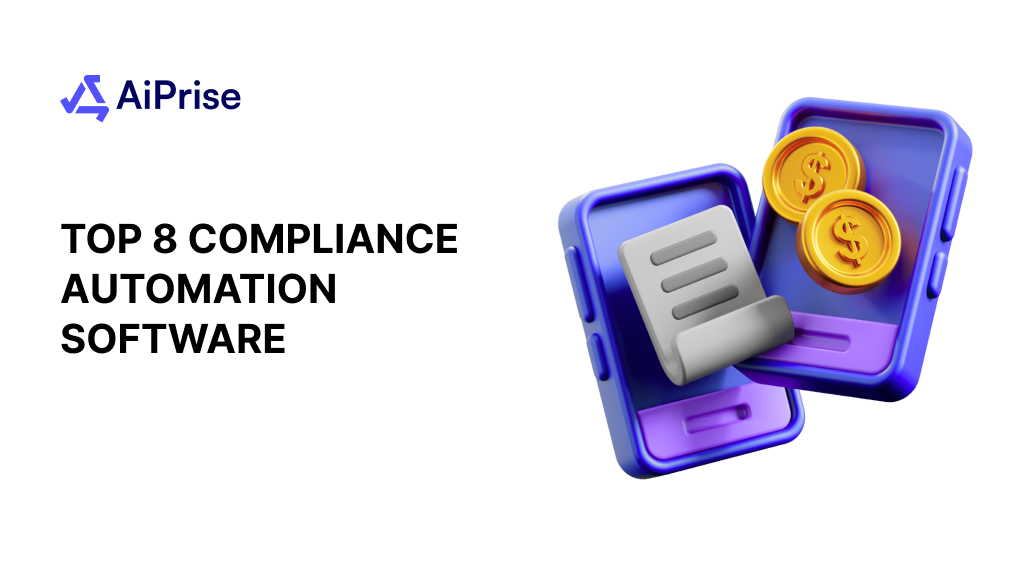
Key Takeaways










Manual compliance creates a critical bottleneck, forcing customers to endure slow onboarding and complex verification processes. This friction comes at a real cost. According to a recent report from Signicat, 68% of consumers have abandoned a digital financial process at least once due to technical barriers or a lack of trust. This highlights a clear choice for modern businesses: either lose customers or find a way to make compliance seamless.
This blog provides a solution to this challenge through compliance automation. We will examine the top tools designed to improve your GRC efforts, helping you choose a platform that ensures audit-readiness and accelerates customer onboarding in 2025.
Key Takeaways
- Manual compliance is a bottleneck. Automation transforms it into a competitive advantage for faster onboarding.
- Choose a tool with seamless integrations and automated workflows. These are key to accelerating verification and creating a smooth user experience.
- The best platform for you is one that aligns with your specific frameworks and business goals.
- A successful transition requires a strategic plan and a structured implementation guide to deliver sustainable results.
What Is Compliance Automation?
Compliance automation is the use of technology to simplify and manage a company's ongoing adherence to regulatory requirements and internal policies. It replaces slow, manual processes, like sifting through spreadsheets and documents, with an automated system to handle repetitive tasks.
For a customer-facing business, this means a faster, smoother, and more secure onboarding experience, as checks like KYC and AML are completed in a fraction of the time. It allows your team to focus on risk management rather than spend time on tedious data collection.
Ultimately, compliance automation represents a fundamental shift from a reactive to a proactive approach. Instead of preparing for an audit once a year, you are continuously monitoring your controls, making your business audit-ready every single day. This change is what enables your business to grow with both speed and security.
With the fundamentals of compliance automation established, the next step is to understand how to select a platform that is right for you.
Also Read: Why Manual Compliance Checks Are Outdated?
How to Choose the Right Compliance Automation Tool?
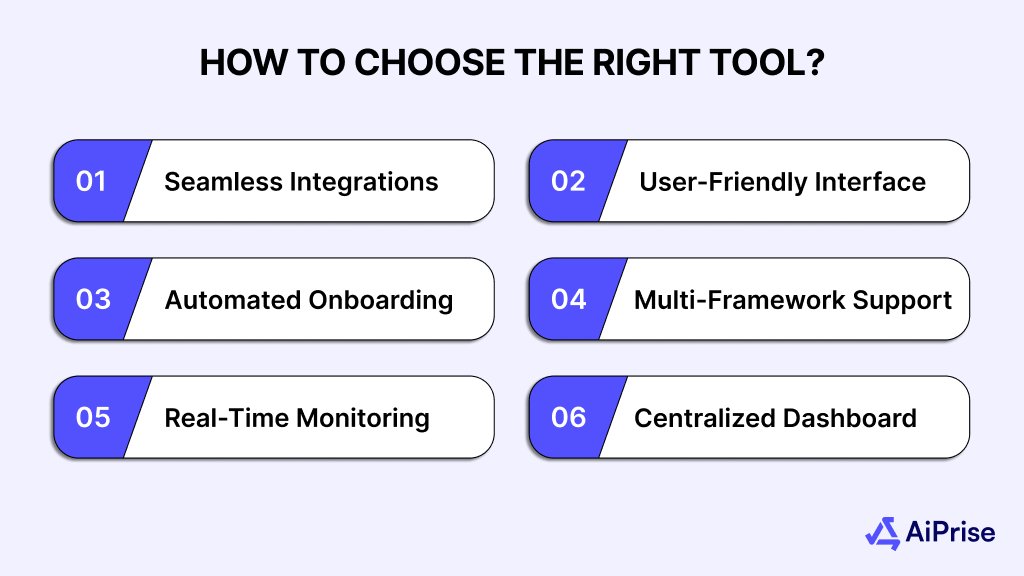
Selecting the right tool is a crucial step in transforming your GRC strategy. The ideal platform should not only automate compliance but also significantly reduce friction for your customers.
Here are the key features to look for in a compliance automation tool that delivers both security and speed:
- Seamless Integrations: The effectiveness of a compliance tool comes from its ability to connect with your tech stack. Look for a platform that links effortlessly to your cloud services, HR systems, and identity verification tools. This enables automatic evidence gathering and orchestrates a single onboarding workflow, which speeds up approvals and reduces manual effort.
- User-Friendly Interface: The platform should be intuitive and easy for your entire team to use, not just compliance experts. A clear, easy-to-use interface lowers the learning curve and minimizes human error, making it easier to manage controls, track progress, and work together.
- Automated Onboarding Workflows: The best platforms offer dedicated features for accelerating customer onboarding. This includes the ability to automate KYC/AML checks, identity verification, and document processing in a single, seamless flow. Automation here means a faster path from application to approval, directly improving the customer experience.
- Multi-Framework Support: A robust tool should handle multiple compliance standards from a single place, such as SOC 2, ISO 27001, and HIPAA. This saves immense time and effort by allowing you to map controls once and apply them across all frameworks, preventing redundant work.
- Real-Time Monitoring and Alerts: Continuous oversight is key. A top-tier tool monitors your environment 24/7 and provides instant alerts for control failures or potential risks. This proactive approach ensures you're always audit-ready and can address issues before they impact your security or slow down operations.
- Centralized Dashboard: Visibility is critical for effective GRC. A single, unified dashboard should provide a clear view of your entire compliance posture, allowing leadership to instantly see audit progress, control status, and high-risk areas, enabling faster and more informed decisions.
With this checklist in hand, you are now equipped to evaluate the market and find the right solution for your business.
Also Read: Why Speed Matters in Customer Onboarding?
8 Best Compliance Automation Platforms for 2025
To help you make an informed decision, we've compiled a list of the top 8 platforms that stand out for their robust features and ability to streamline onboarding.
Here’s a closer look at each one:
1. AiPrise

AiPrise is a modern, all-in-one compliance and risk platform built specifically to accelerate customer and business onboarding. AiPrise unifies identity verification, fraud prevention, and compliance into a single, seamless workflow.
Its main strength lies in its ability to automate Know Your Customer (KYC) and Know Your Business (KYB) checks across more than 200 countries, making it an ideal choice for global businesses in financial services and other highly regulated industries.
Key Features:
- Global KYB & KYC: Provides a single API to verify individuals and businesses in over 200 countries, helping you meet global compliance demands without the need for multiple vendors.
- Automated Onboarding Workflows: Customizable workflows allow you to design a smooth onboarding journey that automatically conducts identity verification, fraud checks, and risk scoring in real-time.
- Comprehensive Fraud Prevention: Utilizes a customizable rule engine and enhanced data from phone, email, and device intelligence to provide ongoing fraud monitoring and risk scoring.
- Compliance Co-Pilot: An AI-powered assistant that helps automate the review of complex documents and generate Enhanced Due Diligence (EDD) reports, drastically reducing manual review time.
- Unified Case Management: A centralized dashboard provides a clear view of all verification statuses, risk profiles, and audit trails, simplifying GRC oversight and ensuring you are always audit-ready.
Best For: Fast, frictionless onboarding with global coverage.
2. Drata

Drata is a security and compliance automation platform built to simplify the path to compliance for a variety of frameworks, with a strong emphasis on SOC 2 and ISO 27001. It is a robust tool that excels at automating the traditionally manual and time-consuming processes of evidence collection and control monitoring. Drata’s platform provides a centralized GRC hub that helps businesses stay audit-ready 24/7.
Key Features:
- Continuous security and compliance monitoring
- Automated evidence collection for audits
- Pre-built policy templates
- Real-time security alerts
- Trust Center for sharing compliance reports
- Centralized risk management
Best For: Streamlining security compliance and achieving SOC 2 certification quickly.
3. Vanta
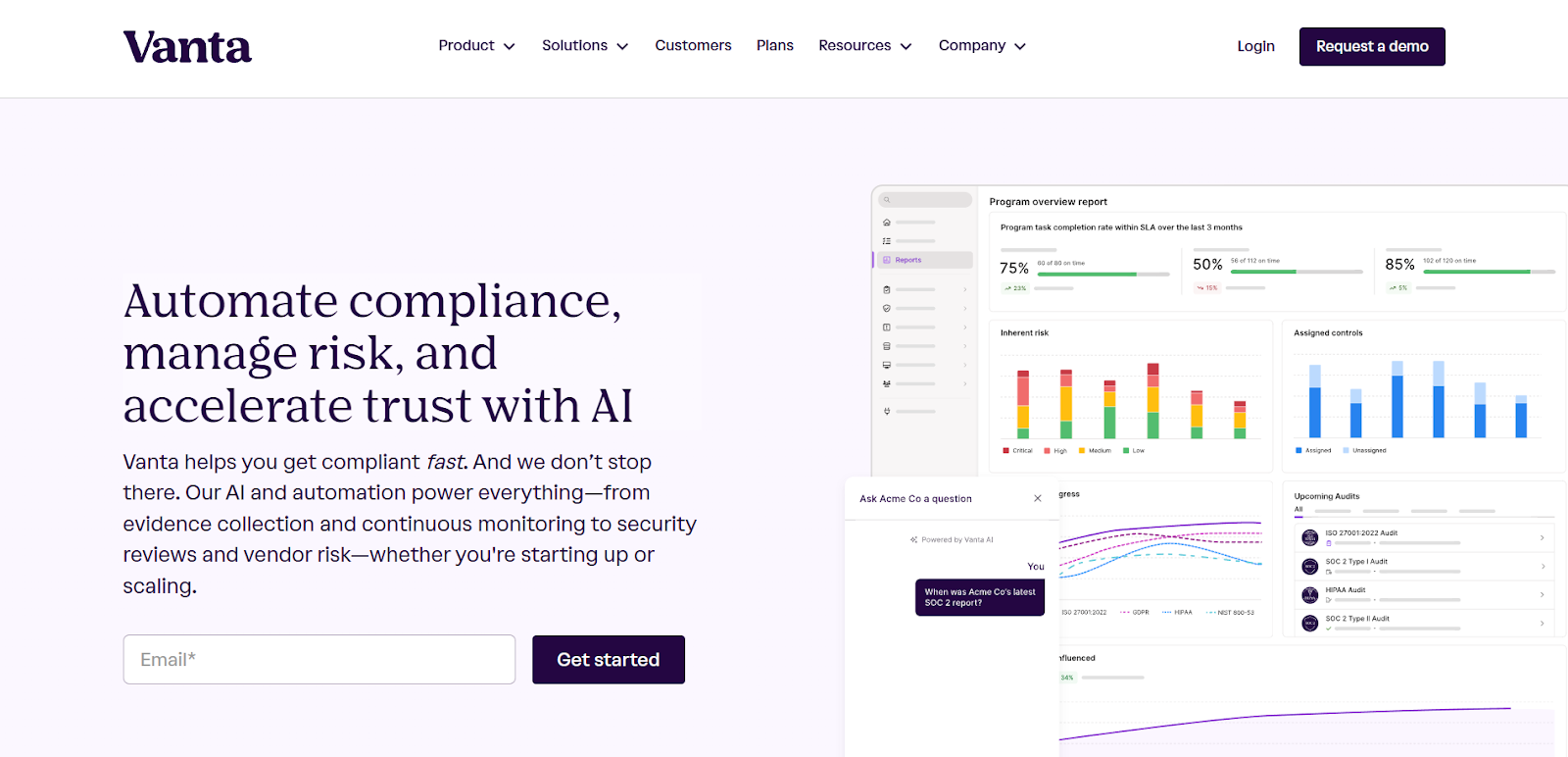
Vanta is a popular compliance automation platform, particularly known for its intuitive user interface and simplified approach to compliance. The platform helps businesses achieve and maintain compliance with frameworks like SOC 2, HIPAA, and GDPR by automating security monitoring and evidence collection.
Key Features:
- User-friendly interface
- Integrates with hundreds of business tools
- Automated security monitoring
- Extensive framework support
- Trust Center for sharing compliance reports
- Policy and document management
Best For: Simplifying compliance for small to medium-sized businesses and startups.
4. Sprinto
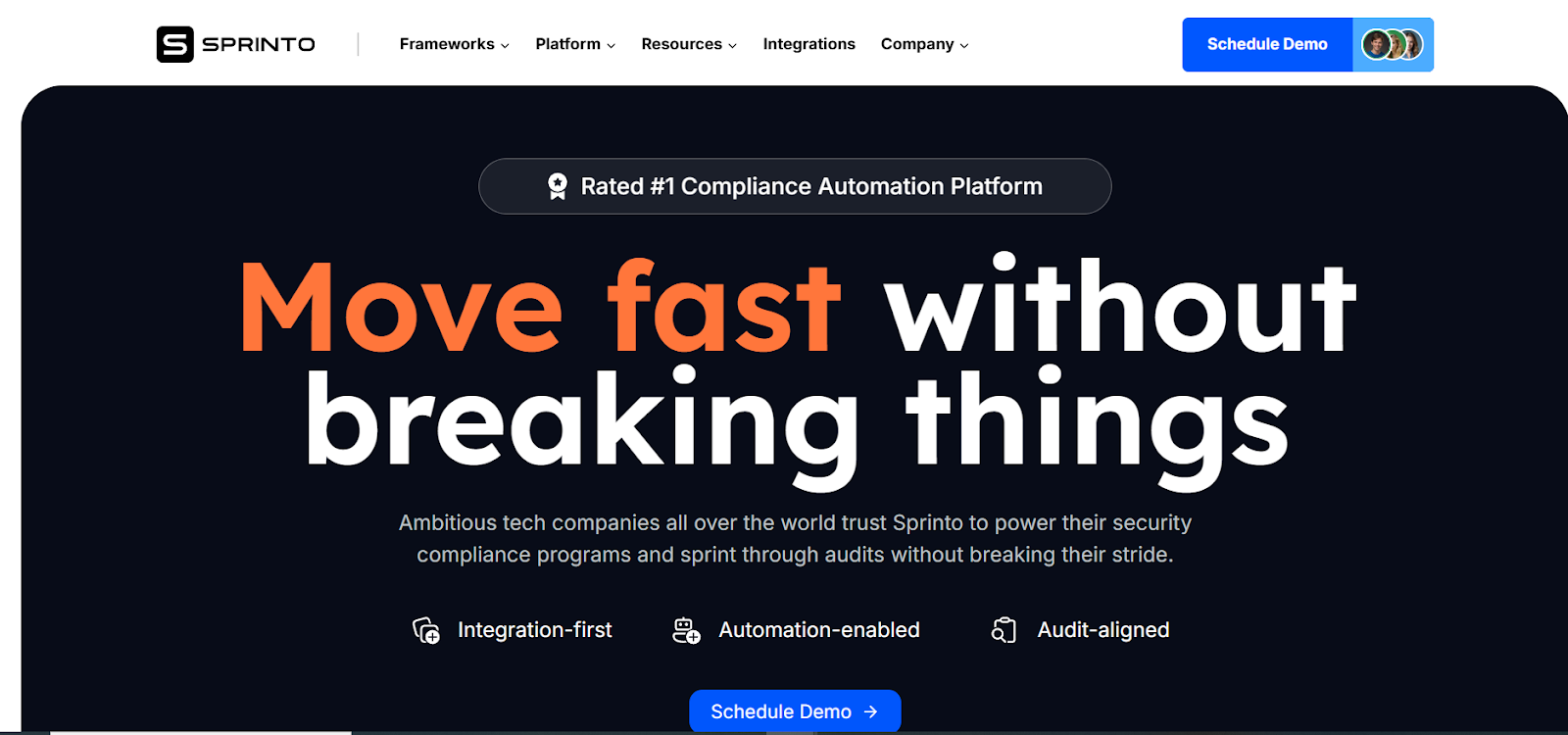
Sprinto is an integration-first compliance platform designed to help cloud-based businesses achieve and maintain security certifications. It simplifies the compliance journey by automating policy, controls, and workflows, making it easier for companies to get certified for frameworks like SOC 2, ISO 27001, and HIPAA.
Key Features:
- Integrates with over 200 cloud services
- Auditor-approved policy templates
- Automated evidence collection
- Vendor risk management
- Real-time compliance dashboard
- Dedicated compliance specialists
Best For: Ensuring security compliance for cloud-first companies.
5. Scrut Automation
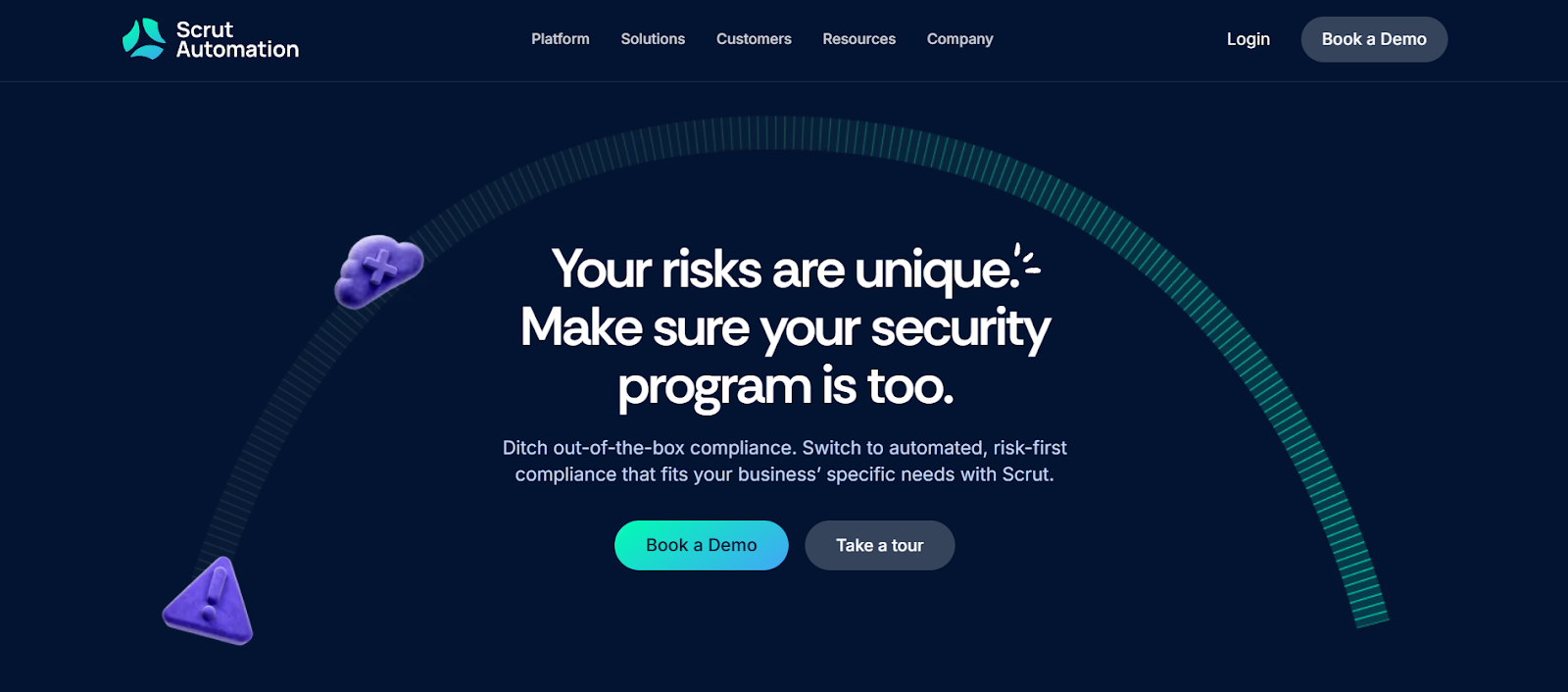
Scrut Automation is a GRC platform that focuses on helping businesses build and manage a robust information security program. It is an all-in-one solution that helps companies move beyond a "bare minimum" approach to compliance by providing a centralized hub to monitor controls, manage risks, and automate audits.
Key Features:
- Supports over 50 compliance frameworks
- Automated evidence collection
- Centralized GRC management
- AI-powered automation
- Vendor risk and asset management
Best For: All-in-one GRC for a security-first approach.
6. Hyperproof

Hyperproof is a security and compliance management platform that helps organizations optimize compliance operations, mitigate risks, and build trust with a centralized, automated platform. It is designed to be a single source of truth for all compliance-related data, automating evidence collection and reporting to reduce manual effort.
Key Features:
- Automated evidence collection
- Centralized GRC platform
- Streamlines security questionnaire workflows
- Real-time risk monitoring
- Supports over 118 frameworks
- Customizable trust center
Best For: GRC operations and building customer trust.
7. OneTrust
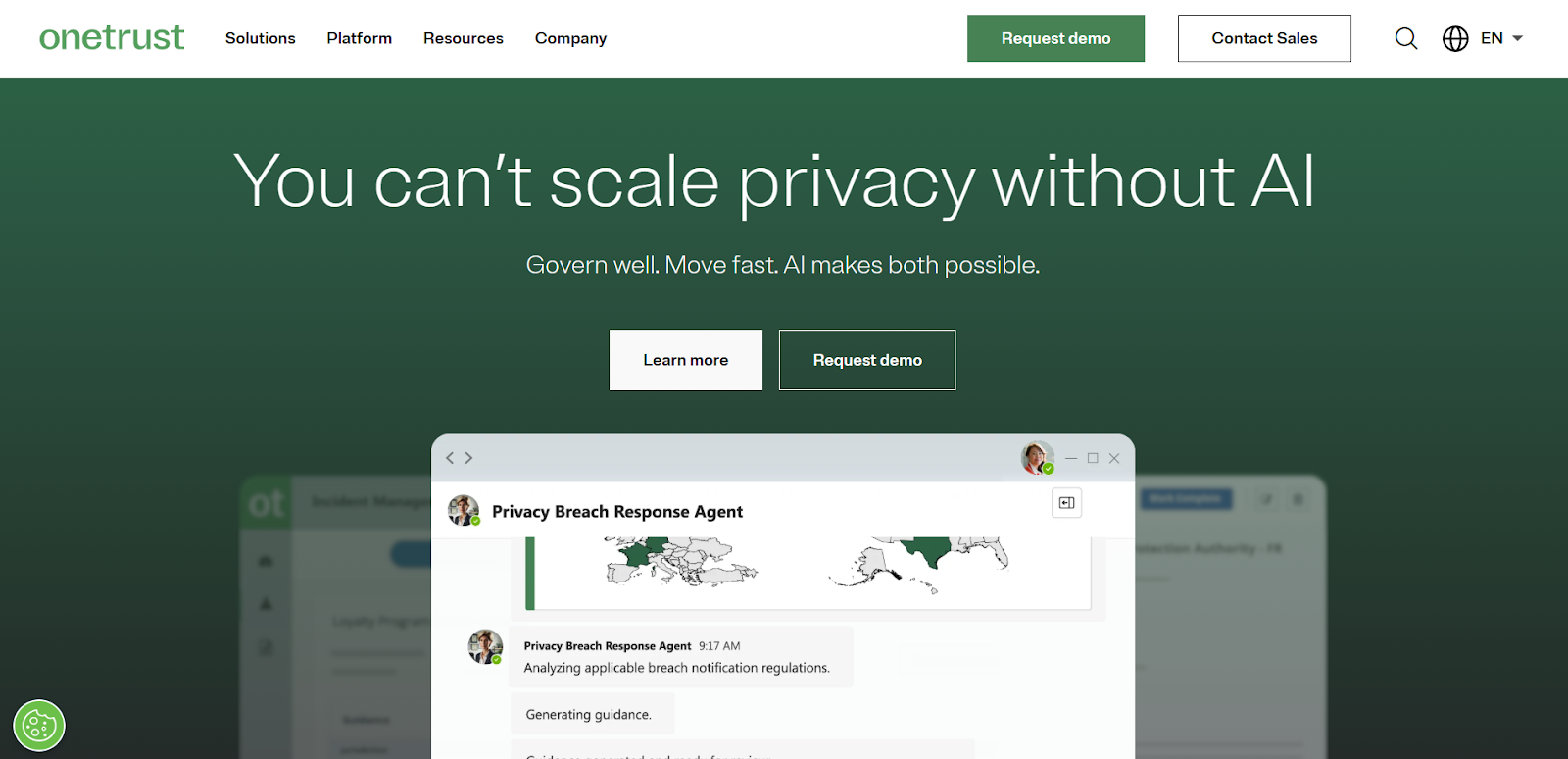
OneTrust is a comprehensive platform designed to help organizations manage their privacy, security, and GRC programs. It offers a suite of tools for everything from consent management and data governance to third-party risk and ethics. OneTrust's platform is built on an intelligent engine that incorporates global regulations, allowing companies to proactively manage compliance and build trust with their customers.
Key Features:
- Consent and preference management
- Automated data discovery and classification
- AI-powered regulatory research
- Third-party risk management
- Ethics and compliance tools
Best For: All-in-one platform for privacy, security, and GRC.
8. Secureframe
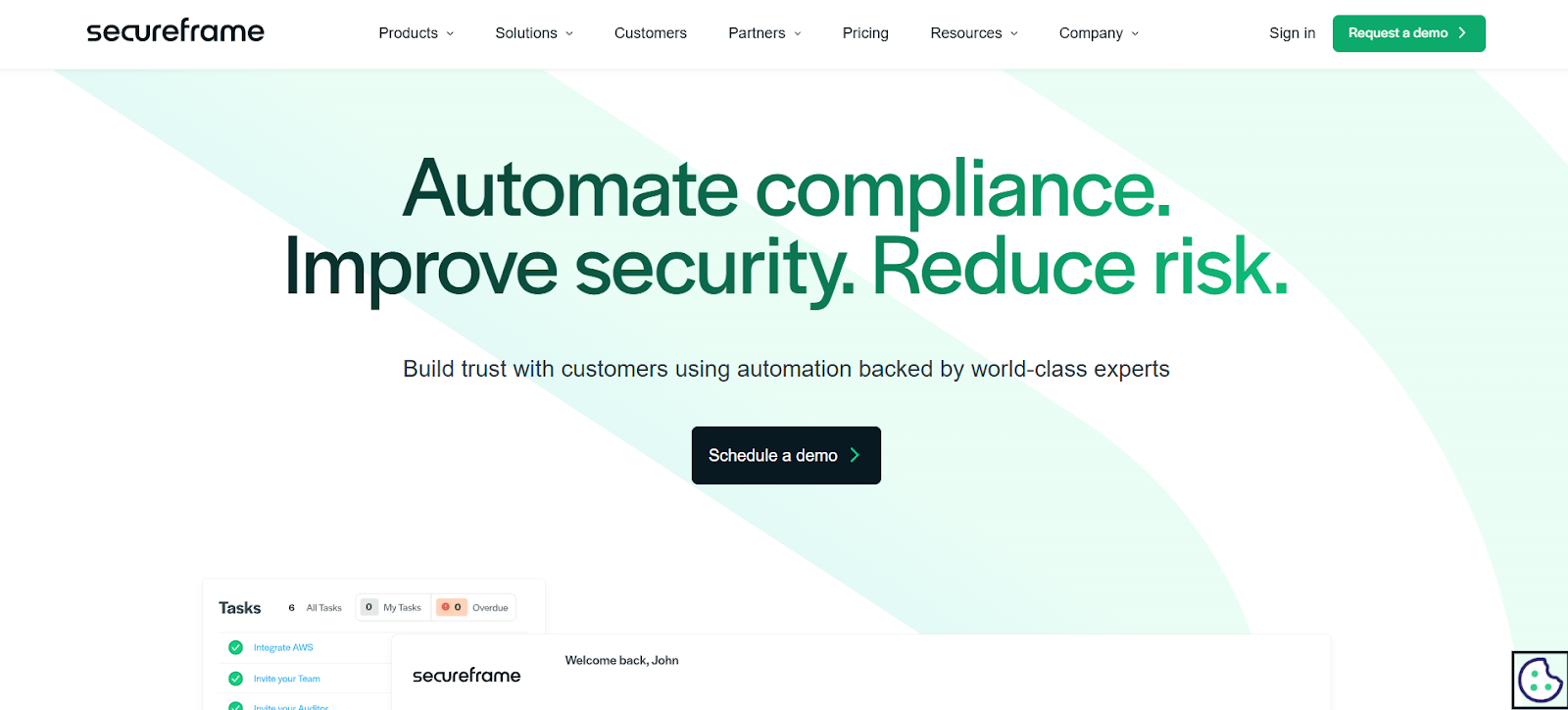
Secureframe is a platform designed to automate security and privacy compliance, helping businesses achieve and maintain certifications like SOC 2, ISO 27001, and HIPAA with speed and ease. The platform provides continuous monitoring, automated evidence collection, and expert-guided workflows to simplify the entire audit process, enabling companies to get certified in a fraction of the time.
Key Features:
- Automated evidence collection and policy management
- One-click integrations for continuous monitoring
- Expert guidance and audit support
- Pre-built compliance frameworks and policies
- Vendor and employee access management
- Real-time risk monitoring
Best For: Fast-tracking security and privacy certifications.
The right compliance automation platform can fundamentally change how your business manages risk and security. The ultimate goal isn't just to buy a tool, but to build on its capabilities for real, tangible results.
Why Does Your Business Need Compliance Automation?
Moving to an automated compliance model provides several advantages that go beyond simply meeting regulatory standards. It's a fundamental change that makes your operations more efficient, secure, and profitable, while also enhancing the customer experience.
Here are the key benefits of compliance automation:
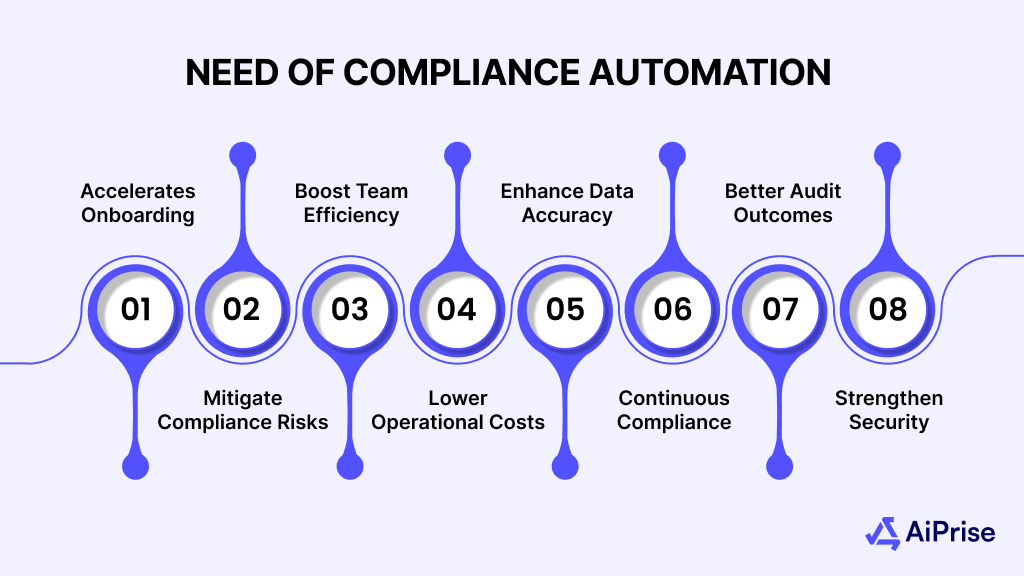
- Accelerate Customer Onboarding: Automation enhances compliance checks like KYC and AML, drastically reducing the time it takes to onboard a new customer or client. This removes friction from the sign-up process, improves the customer experience, and helps your business grow faster.
- Mitigate Compliance Risks: Automation significantly reduces the risk of human error, which is a leading cause of compliance failures. By systematically enforcing policies and controls, the software minimizes the potential for missed deadlines or accidental non-compliance.
- Boost Team Efficiency: Your compliance and GRC teams can stop spending their time on tedious manual tasks like evidence collection and spreadsheet management. Automation frees them up to focus on higher-value activities, such as risk analysis and strategic planning.
- Lower Operational Costs: By reducing the time and resources spent on manual work, your business can significantly cut operational costs. The proactive nature of automation also helps you avoid costly fines and penalties associated with non-compliance.
- Enhance Data Accuracy: Automated systems pull data directly from integrated sources, eliminating the risk of transcription errors and outdated information. This ensures that the evidence and reports you use are consistently accurate and reliable.
- Ensure Continuous Compliance: Instead of being a one-time event, compliance becomes an ongoing process. Automation continuously monitors your environment and alerts you to any potential issues, so you are always in a state of readiness for an audit.
- Achieve Better Audit Outcomes: With all your evidence and documentation automatically organized, accurate, and up-to-date, audits become far less stressful and time-consuming. This improved process leads to smoother reviews and more successful audit results.
- Strengthen Security: Automation helps you enforce security policies and monitor for changes in real time. By linking controls to your security posture, it proactively identifies and flags potential threats, making your entire system more resilient.
With the benefits clearly in view, the next step is to put a plan into action. Here's how to ensure a smooth and successful implementation.
How to Implement Compliance Automation?
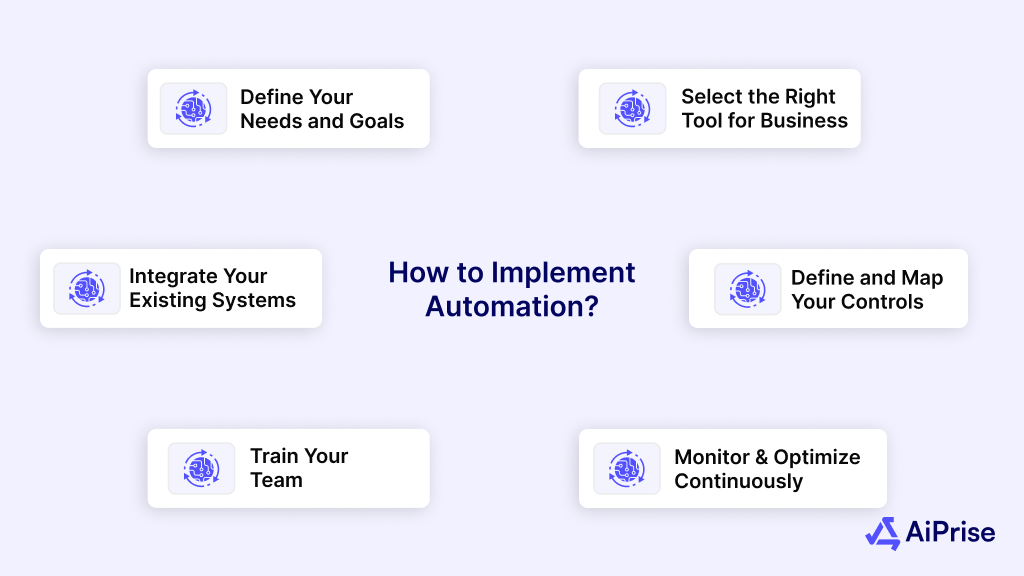
Successfully implementing a compliance automation tool requires careful planning and strategic execution. It's not just about installing new software; it's about transforming your GRC processes.
Here is a practical guide to help you get started and ensure a smooth transition.
- Define Your Needs and Goals: Before you even look at software, clearly define what you want to achieve. What compliance frameworks are you targeting (e.g., SOC 2, HIPAA, ISO)? What are your biggest pain points with your current manual process, such as slow customer onboarding or inefficient verification checks? Understanding your goals will guide your tool selection and implementation strategy.
- Select the Right Tool for Your Business: Look for a platform that aligns with your specific frameworks, integrates with your existing systems, and offers a user-friendly interface. The right tool should feel like a partner, not just a task manager.
- Integrate Your Existing Systems: The power of compliance automation lies in its ability to connect with your tech stack. Work with your IT team to integrate the new platform with your cloud infrastructure (AWS, Azure), HR systems, and project management tools. This is the foundation for automated evidence collection and continuous monitoring.
- Define and Map Your Controls: Once integrated, you can begin defining your security controls and mapping them to your chosen compliance frameworks. The platform will then take over, automatically monitoring these controls and collecting the necessary evidence for each one.
- Train Your Team: A successful implementation relies on team adoption. Provide clear training for your GRC and security teams on how to use the new platform, interpret dashboards, and manage workflows. Ensure everyone understands their role in the new, automated process.
- Monitor and Optimize Continuously: Compliance is an ongoing journey. Use the platform's real-time dashboards to continuously monitor your posture, address any flagged issues promptly, and refine your controls over time. This continuous cycle of monitoring and optimization is the key to maintaining a strong and secure environment.
Following this structured approach ensures that your transition to an automated compliance system is not only successful but also sustainable. It's the foundation for building a resilient GRC program that can scale with your business and keep you secure well into the future.
Conclusion
The move from manual, reactive compliance to a proactive, automated system is a business imperative, not just for reducing risk but for accelerating growth. By embracing compliance automation, you can transform a costly and time-consuming burden into a competitive advantage that improves efficiency, ensures you're audit-ready, and helps you win customers faster.
If your business is ready to unite compliance with fast, frictionless onboarding, AiPrise offers a comprehensive platform designed for exactly that.
Stop risking costly errors and slow onboarding. Book A Demo with AiPrise today to streamline compliance and accelerate your growth.
FAQs
1. How do you automate a compliance check?
Automating a compliance check begins with integrating your platform with your existing tools and services. The software is then configured to perform specific checks, such as using AI to verify a customer's identity during onboarding or running real-time AML screening. The system handles these repetitive tasks automatically, flagging issues and creating a clear audit trail.
2. What is the typical cost of a compliance automation tool?
Costs for compliance tools vary, but they often scale with your business. Pricing can depend on the number of customers you onboard, the volume of transactions, and the frameworks you need to support. For startups, this can range from a few hundred dollars a month, scaling up as your business and compliance needs grow.
3. What is the difference between a GRC platform and a compliance automation tool?
A GRC (Governance, Risk, and Compliance) platform is a holistic solution for managing risk and strategy, while a compliance automation tool is more focused on the tactical process of meeting regulatory standards. For many fintechs, a tool with strong compliance automation features is often the most strategic choice for fast, efficient growth.
4. How long does it take to get a compliance automation tool up and running?
Implementation can vary, but it can be expected to be up and running in a matter of weeks to a few months. The timeline depends on the complexity of your integrations and the number of frameworks you are pursuing. For a startup focused on a single certification, it is a fast process designed to quickly remove onboarding friction.
5. What kind of internal resources are needed to manage these tools?
While these tools automate the heavy lifting, a successful implementation requires a person or team with strategic oversight. Your existing product or security team can often manage the day-to-day operations, but a designated compliance professional is crucial for interpreting reports, defining controls, and engaging with auditors.
You might want to read these...

Aiprise has helped streamline our KYB (Know Your Business) flow in 100+ countries. No other tool comes close.





Speed Up Your Compliance by 10x
Automate your compliance processes with AiPrise and focus on growing your business.





